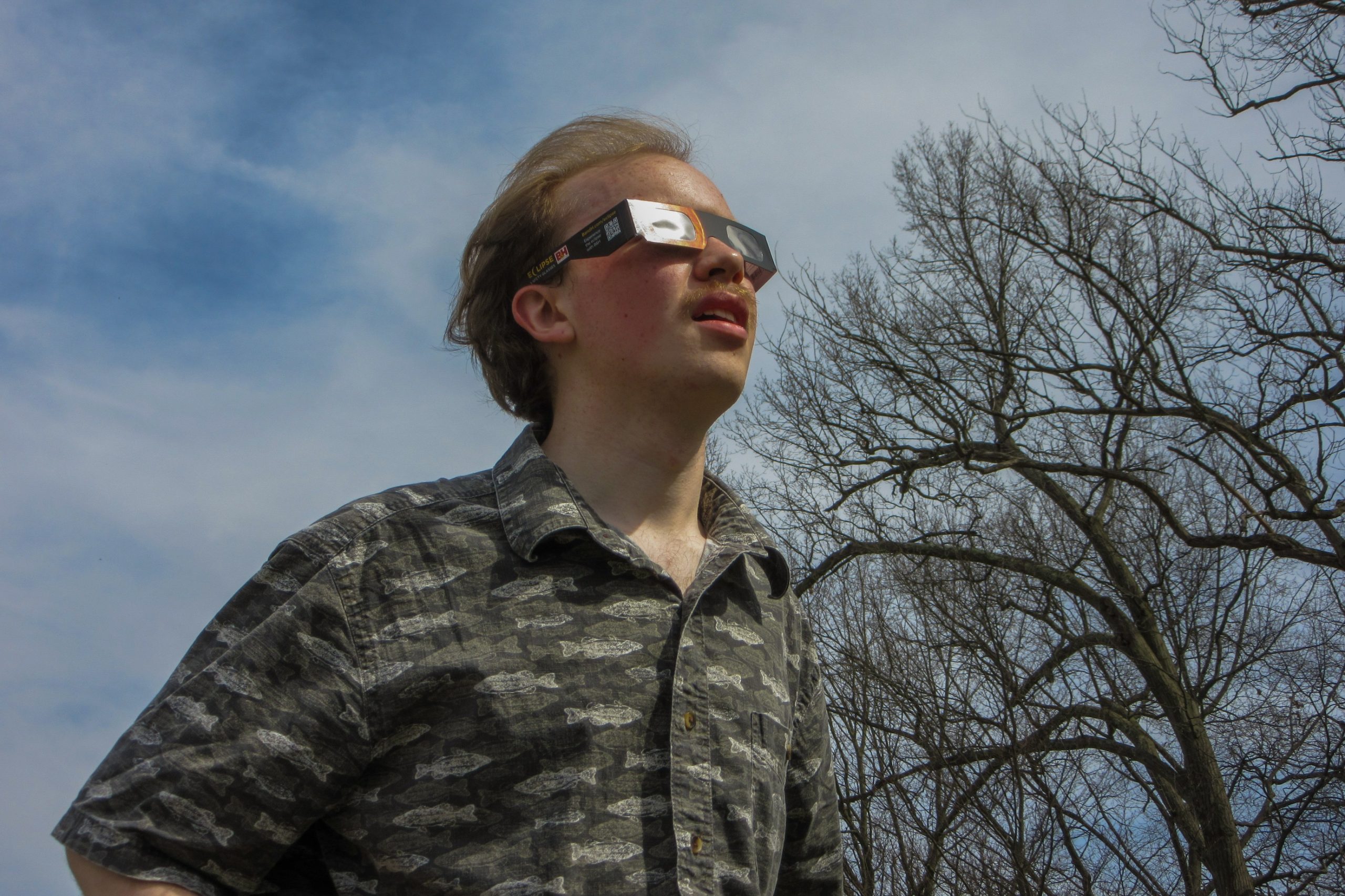
Zach Perrier ’25. viewpoints editor of The Wooster Voice, looks up at the eclipse in awe minutes before totality. Photo by Julia Garrison ’25
Nick Schade
Contributing writer and cartoonist
Hundreds of students, members of the Wooster community and outside visitors gathered on the academic quad in front of Kauke Hall and the residential quad to watch the total solar eclipse on Monday, April 8. The College of Wooster’s physics department and astronomy club worked to organize the campus-wide gathering, providing protective glasses and other viewing equipment to give members of the community a multitude of experiences to view the eclipse.
Monday’s eclipse marks both a rare event and a first for The College of Wooster. The last total solar eclipse visible in Ohio was in 1806, making Monday the first time that the phenomenon has occurred in college history. While much of the continental U.S. saw a partial coverage of the sun, Wooster laid directly in the darkest shadow of the moon, the umbra, providing viewers with a total coverage only visible in a few states. For many students and others present on campus, Monday was the first total solar eclipse they had witnessed in their lifetime.
The partial eclipse began at 2 p.m., with students lining grassy areas of campus with blankets and chairs on both the residential and academic quads, the weather clocking in at a high of 71 degrees while students played football and frisbee. The pinnacle of the event was the total eclipse at 3:13 p.m., when all but the sun’s corona was completely covered by the moon. As the sky darkened and temperature dropped by a notable degree, attendees were able to take off their glasses and view the eclipse with the naked eye. Crowds cheered and stood in awe at the two and a half minutes during which totality was visible from Wooster.
Some students reported seeing insects come out as the sky got darker, though effects on animal behavior in the surrounding area were less noticeable than usually observed with eclipses. Regardless, most viewers expressed awe and amazement after witnessing totality.
“I was on the verge of tears during [the eclipse], that was one of the most beautiful things I’ve ever seen … I’m sure every scientist and every person [who was here] was so happy to have experienced that,” said physics major Eric Johnson ’25.
“It was even more amazing than I thought it was going to be … I found myself to be very moved by the occasion,” said Dr. Laura DeGroot, assistant professor of physics. Monday was the first time that DeGroot had seen a total eclipse.
The College of Wooster’s viewing of the solar eclipse was primarily organized by DeGroot and the astronomy club. DeGroot received a grant from the National Science Foundation which provided 3,000 pairs of protective eclipse glasses to the College. Glasses were also provided a week in advance in Timken and Andrews Library, which were purchased with the help of the Office of the President.
The event was staffed by professors of the physics department and members of the astronomy and physics clubs. At tables around the event, attendees could use sun spotters, which projected the image of the eclipse onto paper via a lens and mirror reflecting light from the sun. Megan Nieberding, visiting assistant professor of physics, also provided a telescope with a special lens, allowing for a closer view of the eclipse.
“I think [the eclipse is] a great way to get lots of people involved in astronomy and science that might not always be a big part of their lives … I think that’s really special [that families and students] can share this, probably once or twice in a lifetime experience with each other, and view the science we’ve been learning about for so long,” said Tali Lansing ’25, president of the physics club and one of the volunteers at the eclipse viewing.
Many professors on campus canceled or ended classes early so that students could see the eclipse. Residents and families from the city of Wooster also visited campus, including local school children, who had the day off due to the eclipse. Some students in the physics departments of colleges from Virginia and West Virginia also traveled to Wooster to see the eclipse on campus.
